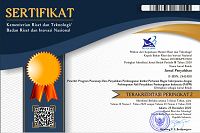Evaluation of the program participatory empowerment Gerbangmas-Taskin at Pandak Daun Village, Banjar Regency
Abstract
Gerbangmas-Taskin is a poverty alleviation program in South Kalimantan province with the concept three (human empowerment, economic and the environment). This study aims to analyze the implementationof Gerbangmas-Taskin effectiveness, to evaluate the sustainability of Gerbangmas-Taskinand prioritize participatory empowerment strategy for effectiveness and sustainability of Gerbangmas-Taskin at PandakDaun Village, Banjar Regency. The methods used include descriptive analysis, RAPfish modification (RAPGerbangmas-Taskin) and Analytical Hierarchy Process (AHP). The data consists of primary data obtained from the results of in-depth interview and a questionnaire given to Poor Households (RTM), while the secondary data obtained from the publication of the relevant agencies. The result showed that Gerbangmas-Taskin program did not impact earnings accretion for the beneficiaries of capital. Gerbangmas-Taskin sustainability index is 34.79 % (less sustainability), consist of :Infrastructure by 62.39% (sustainable enough) while economic, social and environmental showed less sustainable, respectively by 36.85%; 30.22% and 27.11%. The main priority in the strategy of the effectiveness and sustainability of Gerbangmas-Taskin program are the coordination and synergy with the section / SKPD (19%) and increasing the capacity of human resources (16%).
Downloads
References
[BPS] Badan Pusat Statistik. Profil Kemiskinan Provinsi Kalimantan
Selatan Keadaan September 2014.(ID:Badan Pusat
Statistik).Nomor: 005/07/63/Th. XIX, 02 Januari 2011
[BPS] Badan Pusat Statistik. Pendataan Program Perlindungan Sosial.
(ID:Badan Pusat Statistik) Tahun 2011.
[BPMPD] Badan Pemberdayaan Mayarakat dan Pemerintahan
Desa.
Pedoman Umum Gerbangmas-Taskin Provinsi Kalimantan Selatan Tahun
[Laporan]. Provinsi Kalimantan Selatan.
Falatehan AR. 2016. AHP Teknik Pengambilan Keputusan untuk
Pembangunan Daerah.Yogyakarta (ID): Indomedia Pustaka.
Fauzi A. dan Anna S. 2012. Evaluasi Status Keberlanjutan Pembangunan
Perikanan: Aplikasi Pendekatan Rapfish. Jurnal Pesisir dan
Lautan.4(3): 43-55.
Jaya PHI. 2010. Sesat Pikir Pengentasan Kemiskinan: Kasus PNPM
Mandiri Sebagai Model Nasional Pengentasan Kemiskinan,
Yogyakarta (ID): MU3 Communications.
Kavanagh P. and Pitcher TJ. 2004. Implementing Microsoft Excel
Software for Rapfish: A Technique for the Rapid Appraisal of
Fisheries Status. Fisheries Centre Research [Reports]. Colombia
Kavanagh P. 2001. Rapid Appraisal of Fisheries (RAPFISH) Project.
Canada : University of Briitish Columbia.
Murdiansyah. Isnan. 2014. Evaluasi Program Pengentasan Kemiskinan
Berbasis Pemberdayaan Masyarakat (Studi Kasus Pada Program
Gerdu-Taskin di Kabupaten Malang). Jurnal WIGA. 4(1):80-87.
Muslim Aziz. 2017. Analisis kegagalan Program Nasional Pemberdayaan
Masyarakat dalam Membangun Kemandirian Masyarakat Miskin
(Studi Kasus di Provinsi Daerah Istimewa Yogyakarta). Jurnal
Penyuluhan.13(1): 79-87.
Nasdian FT. 2014. Pengembangan Masyarakat. Jakarta (ID):Yayasan
Obor Indonesia
Tesfamichael D and J. Pitcher. 2005. Multidisciplinary evaluation of the
sustainability of Red Sea fisheries using Rapfish. Fisheries
Research.78.227–235.
Prasetyo P, Eko Marimin dan Adang. 2010. Model Kaji Tindak Program
Pembangunan Partisipatif Pengentasan Kemiskinan dan Rawan
Pangan. Jurnal Ekonomi Pembangunan.11(2): 217-235
Soetarto E. dan Sihaloho M. 2008. Desa dan Kebudayaan Petani. Modul
Pembangunan Masyarakat Desa.
Balagaise A, Hartoyo S, Kolopaking Lala M. 2016. Kajian Evaluasi,
Keberlanjutan dan Penguatan Program Gerbangku di Kabupaten
Merauke.[tesis].Bogor (ID): Institut Pertanian Bogor.
Authors who publish with this journal agree to the following terms:
- Authors retain copyright and grant the journal right of first publication with the work simultaneously licensed under a

This work is licensed under a Creative Commons Attribution 4.0 International License that allows others to share the work with an acknowledgement of the work's authorship and initial publication in this journal. - Authors are able to enter into separate, additional contractual arrangements for the non-exclusive distribution of the journal's published version of the work (e.g., post it to an institutional repository or publish it in a book), with an acknowledgement of its initial publication in this journal.
- Authors are permitted and encouraged to post their work online (e.g., in institutional repositories or on their website) prior to and during the submission process, as it can lead to productive exchanges, as well as earlier and greater citation of published work (See The Effect of Open Access).















